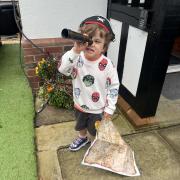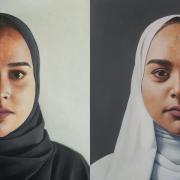Roderick Thackray, who is 80 in June, lives in Mellor, Stockport, less than a mile from where he was born, just below Mellor Church in Brook Bottom, in a former water mill.
It was his uncle Ivan’s stories about exploits working in coal mines around Mellor after the First World War that ignited his passion for industrial architecture. He was soon exploring old mills and coal mines, which he documented and captured in his unique illustrations.
Rod's adventures didn’t come without risks. On one occasion in the mine shafts at Picky Wood Pit in Marple he lost his grip and fell to the bottom only to avoid serious injury when his fall was broken by a dead cow, which had been thrown down by a farmer. And in the tunnels of the disused Ernocroft pit in Compstall he was chased out by some unearthly ghost-like figure, which turned out to be a badger equally shocked by Rod’s presence underground.

By the time he was a teenager, Rod was already an accomplished artist. He developed further at Stockport College of Art, which led him to a career in textile and wallpaper design but his passion for exploring coal mines and coal mining never diminished.
In his spare time, he would help underground at the last working coal mine in the area, high up on Ludworth Moor between Mellor and Charlesworth. The colliery had started mining coal in the late 1920s when Ludworth Moor was part of Derbyshire’s High Peak. Some of those early miners were the same men Rod’s uncle Ivan had worked with. In 1936, Ludworth Moor became part of Cheshire leaving the coal mine straddling the border between the two counties. In 1974, it merged into Greater Manchester, so the coal mine had existed in three counties.
By 1979 Rod was a full-time partner at the private pit, along with Geoffrey du Feu, helping produce some of the finest coal around. Underground operations finally came to an end in July 1981 and for a few years, coal was extracted using opencast methods. Following the closure of the pit all the workings were made safe, the area replanted with trees and shrubs. Today, the area shows no visible evidence of the industry carried out there.


Rod has an incredible talent for capturing the stark and mysterious beauty of industrial architecture and in particular the work and difficult lives of miners. His art captures images of those who worked at Ludworth Moor Colliery from the earliest days up to the closure of the colliery when its colliers were still using some of the most primitive of mining techniques.
Rod has some incredible tales to tell, some about his time working at the coalface, some about the characters that had worked there before, and some unusual and comical stories uniquely captured in his paintings. One of his paintings, for example, shows a table leg used as a pit prop supporting the roof of one of the tunnels. Rod discovered it in 1980 when the tunnel he was working in broke into much older workings. The old workings belonged to brothers Fred and Richard Massey who owned and worked Ludworth Moor Colliery in the 1930s. Fred and Richard never saw eye to eye and argued fiercely about everything. Fred, who was an experienced miner lived in New Mills and Richard lived in a wooden cabin on the site of the colliery. On one occasion Fred needed more timber to shore up the roof; Richard was supposed to have procured it but he was nowhere to be found. Fred stormed up to Richard’s cabin where a furious row broke out which resulted in Richard storming off. Fred immediately smashed his brother's dining table into pieces taking the legs for his pit props. They were still there supporting the roof of the mine when discovered by Rod almost 50 years later.
People often ask Rod if he enjoyed being a coal miner probably expecting him to say how hard it was. The question always brings a wry smile to his face – he says he absolutely loved it, finding it interesting, enjoyable and rewarding. He wouldn’t have missed a minute of it.

Fortunately, Rod’s friend Geoff Cusick was often around with his camera to capture Rod at work. Geoff even made a cine film of the last working day of the colliery. These, together with Rod’s paintings are a fantastic testament to one of the last small-scale working coal mines in what was almost the end of an industry., once employing more than a million workers across the UK.
Rod is also a prolific writer and has published books about the history of Ludworth Moor Colliery, Stirrup Benches Colliery which was just off Glossop Road featuring his uncle Ivan, and has written a novel entitled Mineral Rights, which is loosely based on his experiences of coal mining around Mellor and New Mills.
Northern Art specialists Todmorden Fine Arts, which is displaying and selling Rod's work, say: 'He has great skill in capturing the difficult lives of the miners, especially of those working at the Ludworth Moor Colliery. His work certainly deserves to be admired and collected.'
Todmorden Fine Arts, 27 Water Street, Todmorden, West Yorkshire OL14 5AB
todmordenfineart.co.uk/roderick-thackray/



























